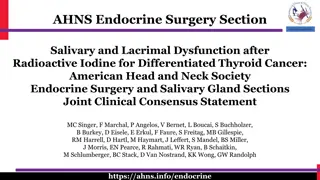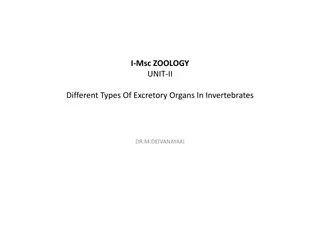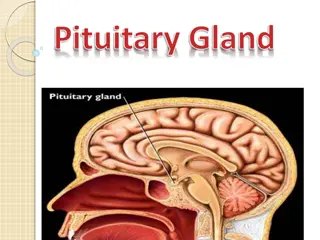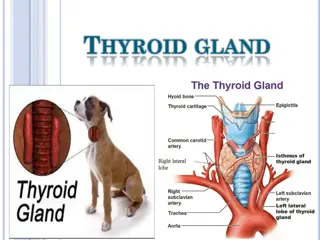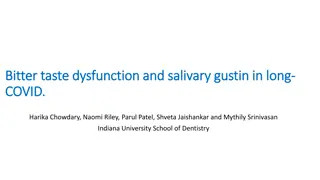The lacrimal system
Disorders of the lacrimal system can lead to chronic symptoms affecting the eyes, causing discomfort and vision problems. Common abnormalities include dry eye, which can result from tear flow and evaporation issues. Aqueous-deficient dry eye, often associated with Sjögren's syndrome, is characteriz
3 views • 38 slides
Understanding Pituitary Gland Functions in Endocrinology Course
Explore the intricate workings of the pituitary gland in endocrinology, delving into hypo- and hyperfunction aspects, hormonal regulation, and physiological characteristics. Learn about the crucial role of hormones, their actions on target organs, and the specificity of their interactions with cellu
6 views • 71 slides
Understanding the Digestive System Processes
The digestive system is responsible for the breakdown, absorption, and elimination of food. It involves processes such as ingestion, propulsion, mechanical and chemical digestion, absorption, and defecation. Starting from the mouth with salivary glands and oral cavity, it progresses through the esop
3 views • 38 slides
SALIVARY GLAND IMAGING
Salivary gland imaging plays a crucial role in diagnosing and monitoring diseases of the major salivary glands, including the parotid, submandibular, and sublingual glands. Different imaging techniques such as computed tomography, MRI, and ultrasound are used to visualize these glands and aid in dif
1 views • 12 slides
Adrenal Gland
This content delves into the detailed structure and function of the adrenal gland, focusing on the differentiation between the cortex and medulla, the histological features of each zone, and the hormones produced. From the distinction of various cortical layers to the role of chromaffin cells in the
0 views • 8 slides
How is Sialoendoscopy Helpful in Curing Salivary Stones? - Dr Sharad ENT
Delve into the examination of sialoendoscopy as a minimally invasive procedure for addressing salivary stones. Gain insights into its potential advantages, associated risks, and comparative analysis with other available treatments.\n\nFor More Visit- \/\/ \/salivary-stones-is-sialoendoscopy-really-t
1 views • 9 slides
Affections of Salivary Glands in Veterinary Surgery: Overview and Treatment
Salivary gland affections in animals, particularly dogs, are discussed, highlighting the main pairs of salivary glands and their locations. The content covers details on the parotid, mandibular, sublingual, and zygomatic glands, along with their respective ducts. Information on congenital and acquir
0 views • 28 slides
Understanding the Thyroid Gland: Functions and Hormone Synthesis
The thyroid gland is a vital endocrine gland located below the larynx, responsible for producing thyroid hormones essential for regulating metabolism. This gland consists of follicles lined with follicular cells, producing thyroglobulin and thyroid hormones T3 and T4. Iodine plays a crucial role in
0 views • 40 slides
Understanding the Pituitary Gland: Implications in Psychiatry
This presentation by Dr. Alexsandra Urhi delves into the anatomy, function, and psychiatric implications of the pituitary gland. It explores the interplay between endocrine structures, the CNS, and psychotropic drugs' effects on the pituitary gland.
0 views • 35 slides
Overview of Pituitary Gland: Structure, Function, and Relationships
The pituitary gland, also known as the hypophysis, is an endocrine gland located at the base of the brain. It is divided into two main parts: the adenohypophysis and the neurohypophysis. The gland plays a crucial role in hormone regulation and is closely related to neighboring structures such as the
0 views • 26 slides
Demonstration of Salivary Amylase Enzyme Action in B.Sc. Practical
Salivary amylase, an enzyme found in saliva, partially hydrolyzes starch into maltose. This practical involves observing the action of salivary amylase on starch, demonstrating how starch is broken down into glucose and maltose. The procedure includes preparing solutions, collecting saliva, mixing w
0 views • 5 slides
Understanding Thyroid Hormones and Their Role in Metabolism
Thyroid hormones, including triiodothyronine (T3) and thyroxine (T4), are essential for regulating metabolism, growth, development, body temperature, and heart rate. They are tyrosine-based hormones produced by the thyroid gland, requiring iodine for synthesis. T3 affects various physiological proce
2 views • 17 slides
Development of Thyroid Gland in Embryonic Stage
The thyroid gland is the first endocrine gland to develop in the human body, starting from a median endodermal thickening in the primitive pharynx. The process involves the descent of the thyroid diverticulum and formation of lobes by week 7 of embryonic development. The thyroid gland begins functio
0 views • 24 slides
Thyroid and Parathyroid Glands Histological Structure Overview
This detailed histological study covers the structure and function of the thyroid and parathyroid glands. It includes information on the stroma, parenchyma, follicular cells, parafollicular cells, and the microscopic structure of the parathyroid gland. The article also delves into the functions of v
0 views • 8 slides
Understanding the Hydrolytic Activity of Salivary Amylase on Starch
Enzymes play a crucial role in catalyzing chemical reactions in the human body. This experiment focuses on the hydrolytic activity of salivary amylase on starch, breaking down polysaccharides into intermediate products like maltose. The mechanism of amylase action, types of amylase, and the assay me
0 views • 16 slides
Understanding the Biochemistry of Addison's Disease in the Endocrine System
Addison's Disease, a primary adrenocortical hypofunction, involves the adrenal gland's cortex and its hormone synthesis. The condition affects aldosterone and cortisol production, impacting electrolyte balance and blood pressure regulation. Learn about the anatomical and histological aspects of the
0 views • 21 slides
Demonstration of Salivary Enzyme Amylase Action in B.Sc. Practical
Salivary enzyme amylase, also known as ptyalin, plays a crucial role in breaking down starch and glycogen into maltose. This practical session in the Zoology department explores the action of salivary enzyme amylase at a temperature of 37°C and pH of 6.6. By conducting experiments with starch, iodi
0 views • 8 slides
Understanding the Microscopic Structure and Function of the Pituitary Gland
Explore the detailed histology of the pituitary gland, focusing on its adenohypophysis and neurohypophysis components. Learn about the diverse parenchymal cells, including acidophils, basophils, and chromophobes, and their respective functions in hormone production. Dive into the significance of the
0 views • 6 slides
Utilization of Glands and Biochemicals in Meat Science Research
Glands play a crucial role in meat science research, with various organs such as pancreas, adrenal glands, and parathyroid gland providing valuable biochemicals like insulin, thyroxine, and corticosteroids. The extraction methods and applications of these glands in food science and medicine are deta
0 views • 25 slides
Structure and Function of a Serous Compound Tubulo-acinar Gland
A detailed description of a compound tubulo-acinar gland with serous-secreting nature is provided, highlighting its cellular composition, arrangement of ducts, and connective tissue organization. The glandular structure, including adenomeres, centroacinar cells, and myoepithelial cells, is discussed
0 views • 15 slides
Thyroxin and Functions of Thyroid Gland
Thyroxin hormone plays a crucial role in regulating body metabolism. Administration of thyroxin boosts oxygen consumption and heat production. The thyroid gland's functions include managing production of thyroxin, leading to hyperthyroidism or hypothyroidism. Disorders such as cretinism and myxedema
0 views • 102 slides
Overview of Gastrointestinal Secretions and Structural Considerations
In this informative presentation by Assistant Professor Dr. Emre Hamurtekin, the focus is on gastrointestinal secretions including salivary, gastric, pancreatic, biliary, and intestinal fluids. Structural considerations such as the surface area for absorption, sphincters, villi, and crypts are discu
0 views • 33 slides
Structure of Gastric Mucosa in Glandular Stomach
The glandular stomach features laminae epithelialis lined with simple columnar epithelium, leading to differentiation into gastric pits and glands. The laminae propria houses tubular gastric glands, while the laminae muscularis mucosa is composed of smooth muscles. Different regions exhibit distinct
0 views • 14 slides
Comprehensive Overview of Salivary Gland Diseases and Management
Salivary gland diseases encompass various conditions affecting the salivary glands, including developmental abnormalities, inflammatory and non-inflammatory enlargement, cysts, tumors, and dysfunction. Investigations such as plain films, sialography, MRI, and biopsies are essential for diagnosis. Si
0 views • 49 slides
Understanding Cushing Disease in Dogs and Cats
The pituitary gland, or "Master Gland," plays a crucial role in hormone regulation in the body. Cushing disease, a common endocrine disorder in middle-aged to older dogs and cats, is often caused by tumors in the pituitary or adrenal glands. Symptoms include increased thirst, appetite, panting, obes
0 views • 22 slides
Understanding Saliva and Salivary Glands in Digestion Process
Saliva is a watery secretion produced by salivary glands in the mouth, aiding in food digestion, swallowing, and moistening food. Human salivary glands include parotid, submaxillary, and sublingual glands, each producing different types of secretions. The glands are made up of secretory acini and du
0 views • 29 slides
Salivary and Lacrimal Dysfunction after Radioactive Iodine Treatment
Radioactive iodine (RAI) is commonly used in treating differentiated thyroid cancer but can lead to salivary and lacrimal dysfunction. This joint clinical consensus statement by the American Head and Neck Society Endocrine Surgery and Salivary Gland Sections highlights the importance of understandin
0 views • 20 slides
Understanding Disorders of the Thyroid Gland: Group 2 Presentation
The thyroid gland, a vital part of the endocrine system, produces hormones that regulate metabolic processes, energy expenditure, and tissue growth. Dysfunction of the thyroid can lead to various disorders affecting overall health. Learn about the functions of thyroid hormones, diagnostic tests, and
0 views • 39 slides
Understanding the Pituitary Gland: Anatomy, Functions, and Disorders
The pituitary gland, also known as the master endocrine gland, plays a crucial role in regulating various hormonal functions in the body. Learn about its anatomy, position, subdivisions, important relations, and common disturbances. Explore how soldiers and individuals like them can be affected by p
0 views • 17 slides
Overview of Salivary Glands Structure
Salivary glands play a crucial role in the production and secretion of saliva, aiding in digestion and oral health. The parotid gland is a compound tubuloacinar gland with serous characteristics, while the sublingual gland is a seromucous type. Minor salivary glands, found in carnivores, vary in com
0 views • 16 slides
Understanding the Endocrine System: Functions, Organs, and Disorders
The endocrine system, essential for bodily functions and growth, consists of key parts such as the hypothalamus, pituitary gland, thyroid gland, and more. It helps maintain homeostasis and can be affected by environmental factors like drugs and stress, leading to conditions such as Cushing syndrome.
0 views • 9 slides
Overview of Salivary Gland Tumors and Diseases
Salivary gland diseases, including tumors, can affect both major and minor glands. These tumors may be benign or malignant, with common benign tumors like pleomorphic adenoma. Clinical features of salivary gland tumors vary, with slow-growing benign tumors being more common. Pleomorphic adenoma is p
0 views • 27 slides
Overview of Different Excretory Organs in Invertebrates
In invertebrates, there are various types of excretory organs such as the contractile vacuole, nephridium, renal gland, coxal gland, and Malpighian tubule. These organs play crucial roles in osmotic regulation and nitrogen excretion. Different phyla exhibit diverse excretory structures like nephridi
0 views • 6 slides
Understanding the Posterior Pituitary Gland and Its Hormones
The posterior pituitary gland, a key part of the endocrine system, plays a vital role in hormone secretion. It controls the release of oxytocin and vasopressin, influencing social bonding, reproduction, and childbirth. Learn about the anatomy, function, and disorders associated with this important g
0 views • 26 slides
Understanding the Pituitary Gland: Structure, Function, and Hormones
The pituitary gland, located at the base of the brain, comprises two main portions - the anterior lobe (adenohypophysis) and the neurohypophysis. The anterior lobe consists of various cell types that secrete hormones like GH, prolactin, TSH, ACTH, FSH, and LH. GH, also known as STH, plays a crucial
0 views • 17 slides
Understanding the Thyroid Gland: Structure, Hormones, and Function
The thyroid gland, a butterfly-shaped structure located on the ventral surface of the trachea, secretes hormones essential for regulating metabolic rate, growth, and development. It produces hormones like Tetraiodothyronine T4, Triiodothyronine T3, and Calcitonin, which play crucial roles in maintai
0 views • 21 slides
Early Life Intervention Diminishes Sjögren's Syndrome Manifestations in Mice
Early life intervention has been shown to reduce the clinical manifestations of Sjögren's syndrome in NOD.H-2h4 mice, which mimic key features of the human autoimmune disease. The syndrome is characterized by salivary gland autoantibodies, ectopic lymphoid follicles, reduced salivary and tear flow,
0 views • 19 slides
Understanding Gastrointestinal Function and Its Regulation by Drugs
The gastrointestinal tract, a muscular tube from the mouth to the anus, is influenced by drugs affecting its function. Structures vary in different animals, with control by the autonomic nervous system branches. Parasympathetic stimulation increases motility, while sympathetic stimulation decreases
0 views • 36 slides
Mammary Gland Pathologies in Mares: Overview & Treatment
This detailed guide explores various pathologies of the mammary gland in mares, including galactorrhea, mastitis, agalactia, and lactation induction. It covers causes, clinical signs, diagnosis, and treatment options for each condition, providing valuable insights for equine healthcare professionals
0 views • 14 slides
Salivary Gustin and Taste Dysfunction in Long-COVID Patients
The research explores the association between taste perception and the duration of COVID infection in long-COVID and COVID-reinfection cases. Reduced salivary gustin levels correlated with lower taste scores in long-COVID patients. The study also found an increase in the bitter taste receptor gene e
1 views • 4 slides


























